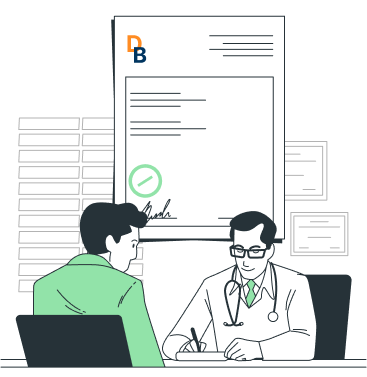Expert Hernia
What is Hernia?
A hernia occurs when there is a weakness or opening in the abdominal wall, allowing soft tissue, such as fat or intestines, to push through the muscles and create a visible bulge under the skin. This causes a lump or bulge to form.
Common Types of Hernia
.jpg)
Inguinal Hernia
An inguinal hernia occurs when a portion of the intestine or abdominal tissue pushes through a weak spot in the lower abdominal wall, often near the inguinal canal.

Umbilical Hernia
An umbilical hernia occurs when part of the intestine or abdominal tissue bulges through a weak spot near the belly button (umbilicus).

Hiatal Hernia
When the stomach pushes through the opening of the diaphragm, it appears as a bulge in the chest.

Femoral Hernia
A femoral hernia occurs when abdominal tissue, such as part of the intestine, pushes through a weak spot in the lower abdomen, just below the inguinal ligament, into the femoral canal.

Incisional Hernia
An incisional hernia occurs when tissue protrudes through a weakened area of the abdominal wall at the site of a previous surgical incision.
Common Types of Hernia
.jpg)
Inguinal Hernia
An inguinal hernia occurs when a portion of the intestine or abdominal tissue pushes through a weak spot in the lower abdominal wall, often near the inguinal canal.

Umbilical Hernia
An umbilical hernia occurs when part of the intestine or abdominal tissue bulges through a weak spot near the belly button (umbilicus).

Hiatal Hernia
When the stomach pushes through the opening of the diaphragm, it appears as a bulge in the chest.

Femoral Hernia
A femoral hernia occurs when abdominal tissue, such as part of the intestine, pushes through a weak spot in the lower abdomen, just below the inguinal ligament, into the femoral canal.

Incisional Hernia
An incisional hernia occurs when tissue protrudes through a weakened area of the abdominal wall at the site of a previous surgical incision.
Frequently Asked Questions
Swelling is common after surgery and starts to decrease within 1-2 weeks. Full resolution of swelling can take several weeks, with the most significant reduction occurring within the first 2-4 weeks.
Most patients experience some level of discomfort after hernia surgery, but pain is usually manageable with medications. Laparoscopic surgery often results in less post-operative pain compared to open surgery due to smaller incisions. Most people find that pain subsides significantly within a few days to weeks.
Surgery is recommended for hernias that are symptomatic, growing, or causing complications. There are no strict size specifications, but larger hernias and those that cause significant discomfort or risk complications are more likely to require surgical intervention.
In some cases, a hernia may not require immediate surgery, especially if it's small and not causing symptoms. Non-surgical options include hernia belts, lifestyle changes and monitoring. For some individuals, especially if the hernia is asymptomatic, regular monitoring by a hernia doctor might be sufficient.
The choice of surgery depends on various factors, including the size and type of hernia, patient health, and surgeon preference. The main options include laparoscopic surgery and open surgery.
For symptomatic hernias, surgery is usually recommended sooner rather than later. For asymptomatic hernias, surgery might be scheduled based on patient convenience and surgeon’s recommendation.
After laparoscopic inguinal hernia surgery, do follow your surgeon's instructions, manage pain as directed, and avoid heavy lifting or strenuous activities. Don’t ignore symptoms of complications, engage in vigorous exercise too soon, or smoke, as these can affect healing and recovery.
Hernia surgery is generally considered safe with a low risk of complications. The risks include infection, bleeding, recurrence of the hernia, and reactions to anaesthesia. Choosing a skilled surgeon and following post-operative care instructions can help minimise these risks.
Try to sleep on your back or side, avoiding positions that put pressure on the surgical area. Some people find using pillows for support helpful.
Diagnosis Before Hernia Treatment
The diagnostic process for hernia treatment has been explained below by the hernia doctors.
- Physical examination: A doctor will check the affected area, looking for a bulge or lump. They may also check for tenderness or discomfort.
- Medical history: Patients must usually report their initial symptoms and some factors which enhanced the pain to the hernia surgery doctor. They also need to provide information regarding existing medical conditions, age, health and previous history of any surgery.
- Imaging tests:
- Ultrasound:This non-invasive test utilises sound waves to create images of the hernia.
- CT scan: A more detailed imaging test that can help visualise the hernia and its surrounding structures.
- MRI:>Another imaging test that provides high-quality images of the hernia and adjacent tissues.
To reduce the chances of complications during and after hernia surgery, it is important to undergo some additional tests like ECG. These tests also help ensure that the patient is in good health and suitable for hernia surgery.
Treatments for Hernia
-
1. Observation:
If the hernia is small and not a cause of discomfort, doctors may suggest monitoring to see if it becomes symptomatic or grows. -
2. Support garments:
Doctors also suggest support garments to keep the hernia in place. However, they must only be used under medical guidance. -
3. Surgery:
Surgery is considered to be the most effective treatment for hernias, especially if they are causing pain or discomfort. This also helps prevent its recurrence.

Surgical Treatments for Hernia
There are three hernia surgery types which have been listed below.
Open Surgery:
This helps make a large incision in the affected area, repair the hernia, and often using a mesh to reinforce the weakened tissue.
Laparoscopic Surgery:
This minimally invasive technique uses small incisions and a camera to check the inside of the abdomen. The hernia is repaired using specialised instruments.
Robotic Surgery:
Robotic surgery for hernia repair is a minimally invasive technique that uses a robotic system controlled by a surgeon to fix the hernia.
Comparison Between Open and Laparoscopic Hernia Surgery
Here is a comparative analysis of two hernia repair operations-
| Factors | Open Hernia Surgery | Laparoscopic Hernia Surgery |
|---|---|---|
| 1. Surgical Technique | It involves a large surgical incision | It involves small incisions and a camera |
| 2. Recovery Time | Longer recovery time | Shorter recovery time |
| 3. Pain | More postoperative pain due to invasive approach | Less postoperative pain due to minimally invasive approach |
| 4. Chances of Complications | High chance of complications | Minimal chances of complications |
| 5. Recurrence | Moderate to high risk of hernia recurrence | Minimal risk of recurrence |
| 6. Advantages | Helps in performing complex surgeries | Improved precision |
| 7. Preference | Doctors recommend open hernia surgery based on the condition of the patient and the severity of the situation. | It is now being preferred more than open surgery because of less pain and fast recovery |
Advantages of Hernia Laparoscopic Surgery
Laparoscopic hernia surgery offers several significant advantages over traditional open surgery which have been discussed below by hernia doctors.
Smaller incisions:
All types of laparoscopic surgeries involve making tiny incisions, resulting in less pain and scarring.
Quicker recovery:
Due to the smaller incisions, patients generally experience a faster recovery time, allowing them to return to their normal activities sooner.
Reduced risk of complications:
Laparoscopic surgery is generally associated with a lower risk of complications in comparison to open surgery.
Shorter hospital stay:
Patients undergoing laparoscopic hernia surgery often require a shorter hospital stay than those undergoing open surgery.
Improved cosmetic outcome:
The smaller incisions used in laparoscopic surgery lead to a more aesthetically pleasing outcome.
Less postoperative pain:
Patients may experience less pain after laparoscopic surgery compared to open surgery.
Reduced risk of infection:
The smaller incisions and less handling of tissues can reduce the risk of infection.
Low blood loss:
Laparoscopic surgery generally results in less blood loss compared to traditional open surgery due to its minimally invasive nature. In this technique, small incisions are made rather than large cuts, reducing damage to surrounding tissues and blood vessels.
How to Prepare for Laparoscopic Hernia Surgery?
Preparing for laparoscopic hernia surgery involves several steps to ensure a smooth procedure and recovery.
Consult with Your Surgeon:
Discuss the procedure and benefits with the hernia surgeon. Make sure to ask about any specific instructions or preparations you need to follow.
Preoperative Testing:
Depending on your health and medical history, you may need tests such as blood tests, an ECG or a chest X-ray.
Avoid certain medications:
Stop taking blood thinners or aspirin as instructed by the hernia treatment doctor.
Quit smoking and limit alcohol:
Doctors usually recommend patients don't smoke or drink before hernia surgery as it can impact the outcome of the procedure.
What Happens During Laparoscopic Hernia Surgery?
The best hernia surgeon has mentioned below the steps that are involved in hernia surgery.
Anaesthesia:
You will be given general anaesthesia, which means you will be asleep and pain-free throughout the surgery.
Positioning:
You will be positioned on the operating table, usually lying on your back.
Small Incisions:
The surgeon makes several small incisions in the abdominal wall. These are usually located around the belly button and/or other areas, depending on the hernia's location.
Laparoscope:
A thin tube with a camera and light at the end, called a laparoscope, is inserted through one of the incisions. This allows the surgeon to view the internal structures on a monitor
Pumping Carbon Dioxide:
Carbon dioxide gas is gently pumped into the abdominal cavity to create space and improve visibility.
Identifying the Hernia:
The surgeon uses the laparoscope to locate the hernia and assess its size and the surrounding tissue.
Reducing the Hernia:
The herniated tissue is pushed back into its proper place.
Reinforcing the Abdominal Wall:
A mesh patch is often used to reinforce the abdominal wall and prevent the hernia from recurring. The mesh is usually secured with sutures or staples.
Removing Instruments:
Once the repair is complete, the laparoscope and other instruments are removed
Sealing Incisions:
The small incisions are closed with stitches, staples, or adhesive strips. In some cases, dissolvable stitches are used.
What to Expect After Your Laparoscopic Hernia Surgery?
After laparoscopic hernia surgery, you can generally expect the following:
1. Immediate After Surgery:
- Pain: You may experience some discomfort or pain around the surgery site, but it’s usually manageable with prescribed pain medications.
- Nausea: It’s common to feel a bit nauseous due to anaesthesia, but this should subside within a day or two.
2. First Few Days:
- Activity: You will need to rest and avoid strenuous activities. Light walking is encouraged to aid in recovery.
- Incision Care: Keep the surgical site clean and dry. Follow the surgeon's instructions for wound care.
What to Look Out For
Signs of Infection:
Redness, increased swelling, warmth, or discharge at the incision site.
Persistent Pain:
Severe or worsening pain that does not improve with medication.
Fever:
A high fever can be a sign of infection or other complications.
Changes in Bowel or Urinary Function:
Especially if accompanied by severe pain or discomfort.
What is the Recovery Time After Laparoscopic Hernia Surgery?
Hernia treatment recovery time has been explained below.
After Surgery (First 1-2 Days)
-
Pain and Discomfort:
You may experience some pain and discomfort, which is usually managed with prescribed pain medications. -
Activity:
You should rest, but light walking is encouraged to promote circulation and prevent complications.
Short-Term Recovery (First 1-2 Weeks) after surgery
-
Pain:
Pain should gradually decrease. Most people find that pain is manageable with prescribed medications. -
Incision Care:
Follow the surgeon’s instructions for wound care. The incisions will be small and should heal relatively quickly. -
Activity:
You can usually return to light activities within a few days. However, avoid heavy lifting, strenuous exercise, or activities that could strain the surgery site.
Intermediate Recovery (2-4 Weeks)
-
Activity Level:
You may start to resume more normal activities but still avoid heavy lifting and intense physical activities. -
Follow-Up Appointment:
You might have a follow-up visit with the surgeon to assess your recovery and remove any stitches or dressings if needed.
Full Recovery (1-3 Months)
-
Normal Activities:
Most people can return to their normal activities within a few weeks, but complete recovery, where you can fully return to strenuous activities, might take 1 to 3 months. -
Swelling and Bruising:
Any swelling or bruising around the incisions should subside. It’s normal for these to take some time to fully resolve.
Dos and Don’ts after Laparoscopic Hernia Surgery?
Follow these dos and don’ts as a part of your hernia surgery aftercare.
Dos:
1. Follow The Surgeon’s Instructions:
Follow all post-operative care instructions, including medication schedules, wound care, and activity restrictions.
2. Manage Pain and Discomfort:
Take prescribed pain medications as directed. Use ice packs on the surgical area if recommended to reduce swelling.
3. Do Gradually Increase Activity:
Start with light activities, such as walking, to promote circulation and prevent blood clots. Gradually increase your activity level as you feel able, based on your surgeon’s advice.
4. Do Keep Incisions Clean and Dry:
Follow instructions for caring for your incisions. Keep them clean and dry, and avoid submerging them in water (such as in baths or pools) until fully healed.
5. Do Stay Hydrated and Eat a Balanced Diet:
Drink plenty of fluids and eat a diet rich in fibre to help prevent constipation, which can strain the surgical area.
Don’ts:
1. Don’t Engage in Heavy Lifting or Strenuous Activities:
Avoid lifting heavy objects, engaging in intense physical exercise, or participating in activities that strain your abdominal muscles until cleared by the surgeon.
2. Don’t Ignore Pain or Discomfort:
If you experience severe or worsening pain, or if the pain doesn’t improve with medication, contact the hernia surgeon.
3. Don’t Drive Until Cleared:
Avoid driving until your surgeon confirms that it’s safe to do so, especially if you are still taking pain medication that could impair your ability to drive.
4. Don’t Skip Medications or Instructions:
Skipping medications or not following care instructions can lead to complications or delay your recovery.
5. Don’t Use Harsh or Irritating Products on Incisions:
Avoid applying creams, ointments, or other substances to the incision site unless directed by the hernia doctor.
Laparoscopic Hernia Surgery Cost in Kolkata
Hernia treatment costs may vary based on the following factors.
- Type and Severity of the Hernia
- Surgeon’s Fees
- Hernia Mesh
- Preoperative Diagnostics
- Pre and Post-operative care and cost of medications
- Hospitalisation Costs
Hernia surgery expenses usually depend on these factors. To know more, reach out to our laparoscopic hernia doctor.
Our Patient Love Us
Get in Touch
Tell us about your disease and Dactar Babu will get the best treatment option for you.


_(1).png)






